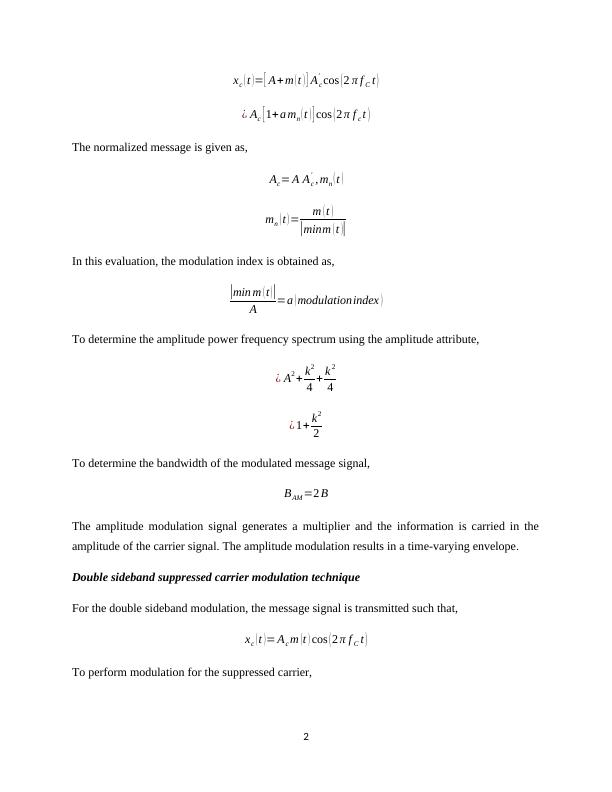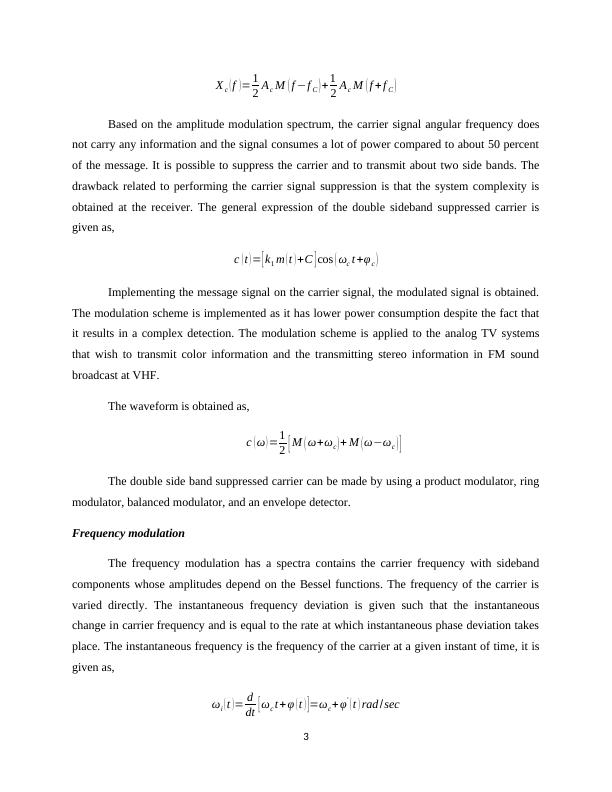Analog Modulation Techniques: Amplitude, DSB-SC, and FM
Added on 2023-04-19
15 Pages3658 Words114 Views
Communications Module
Assignment
Student name
Student ID Number
Date of submission
12/19/2018
Assignment
Student name
Student ID Number
Date of submission
12/19/2018

PART I
INTRODUCTION
A communication system carries information from one source point to a destination
through a reliable medium. There are issues that arise with the transmission of baseband signals.
The limitations of baseband transmission can be overcome using the modulation. It is the
technique in which the baseband signal is translated from lower frequency on to higher
frequency of the carrier wave. In the analogue communications, the modulation techniques are
categorized into linear and non-linear modulation schemes. The linear modulation schemes are
given as the amplitude modulation, double sideband suppressed carrier amplitude modulation,
single sideband suppressed carrier amplitude modulation, and vestigial sideband modulation. The
non-linear modulation schemes are given as frequency modulation and phase modulation.
There are three parameters in a signal that can be varied for modulation namely the
amplitude, the phase, and the frequency. Any communication system has a transmitter, receiver,
and wired or wireless channels. A communication system may seek to perform modulation to
ensure efficient transmission, multiplexing, frequency assignment, to improve signal to noise
ratio, and ease of radiation. In the modulation process, some of the signal attributes are altered to
get to that of a high frequency carrier signal which changes with the instantaneous amplitude of
the information signal. Modulation is suitable for signal transmission over long distances,
stability and noise rejection as well as the capacitive or inductive device implementation for
frequency AC input carrier to operate. Some of the common examples of modulation are the
mobile radio communications such as the cellular networks. The process of shifting the baseband
signals to the pass band range is the modulation of signals. The reverse process converts the pass
band range signals to the baseband signals by demodulation.
Amplitude modulation
The carrier signal modulates the amplitude section only. The modulating signal has an envelope
of the carrier. The total bandwidth required in the amplitude modulation is determined from the
signal. The message signal is transmitted through the carrier by adding a DC bias to the message
signal. Take the carrier signal to be cos ( 2 π f C t ) while the modulating message signal is given as,
cos ( 2 π f m t ). The AM signal is given as,
1
INTRODUCTION
A communication system carries information from one source point to a destination
through a reliable medium. There are issues that arise with the transmission of baseband signals.
The limitations of baseband transmission can be overcome using the modulation. It is the
technique in which the baseband signal is translated from lower frequency on to higher
frequency of the carrier wave. In the analogue communications, the modulation techniques are
categorized into linear and non-linear modulation schemes. The linear modulation schemes are
given as the amplitude modulation, double sideband suppressed carrier amplitude modulation,
single sideband suppressed carrier amplitude modulation, and vestigial sideband modulation. The
non-linear modulation schemes are given as frequency modulation and phase modulation.
There are three parameters in a signal that can be varied for modulation namely the
amplitude, the phase, and the frequency. Any communication system has a transmitter, receiver,
and wired or wireless channels. A communication system may seek to perform modulation to
ensure efficient transmission, multiplexing, frequency assignment, to improve signal to noise
ratio, and ease of radiation. In the modulation process, some of the signal attributes are altered to
get to that of a high frequency carrier signal which changes with the instantaneous amplitude of
the information signal. Modulation is suitable for signal transmission over long distances,
stability and noise rejection as well as the capacitive or inductive device implementation for
frequency AC input carrier to operate. Some of the common examples of modulation are the
mobile radio communications such as the cellular networks. The process of shifting the baseband
signals to the pass band range is the modulation of signals. The reverse process converts the pass
band range signals to the baseband signals by demodulation.
Amplitude modulation
The carrier signal modulates the amplitude section only. The modulating signal has an envelope
of the carrier. The total bandwidth required in the amplitude modulation is determined from the
signal. The message signal is transmitted through the carrier by adding a DC bias to the message
signal. Take the carrier signal to be cos ( 2 π f C t ) while the modulating message signal is given as,
cos ( 2 π f m t ). The AM signal is given as,
1

xc ( t ) = [ A+ m ( t ) ] Ac
' cos ( 2 π f C t )
¿ Ac [ 1+a mn ( t ) ] cos ( 2 π f c t )
The normalized message is given as,
Ac= A Ac
' , mn ( t )
mn ( t ) = m ( t )
|minm ( t )|
In this evaluation, the modulation index is obtained as,
|min m ( t )|
A =a ( modulationindex )
To determine the amplitude power frequency spectrum using the amplitude attribute,
¿ A2 + k2
4 + k 2
4
¿ 1+ k2
2
To determine the bandwidth of the modulated message signal,
BAM =2 B
The amplitude modulation signal generates a multiplier and the information is carried in the
amplitude of the carrier signal. The amplitude modulation results in a time-varying envelope.
Double sideband suppressed carrier modulation technique
For the double sideband modulation, the message signal is transmitted such that,
xc ( t )= Ac m (t ) cos ( 2 π f C t )
To perform modulation for the suppressed carrier,
2
' cos ( 2 π f C t )
¿ Ac [ 1+a mn ( t ) ] cos ( 2 π f c t )
The normalized message is given as,
Ac= A Ac
' , mn ( t )
mn ( t ) = m ( t )
|minm ( t )|
In this evaluation, the modulation index is obtained as,
|min m ( t )|
A =a ( modulationindex )
To determine the amplitude power frequency spectrum using the amplitude attribute,
¿ A2 + k2
4 + k 2
4
¿ 1+ k2
2
To determine the bandwidth of the modulated message signal,
BAM =2 B
The amplitude modulation signal generates a multiplier and the information is carried in the
amplitude of the carrier signal. The amplitude modulation results in a time-varying envelope.
Double sideband suppressed carrier modulation technique
For the double sideband modulation, the message signal is transmitted such that,
xc ( t )= Ac m (t ) cos ( 2 π f C t )
To perform modulation for the suppressed carrier,
2

X c ( f ) = 1
2 Ac M ( f −f C ) +1
2 Ac M ( f + f C )
Based on the amplitude modulation spectrum, the carrier signal angular frequency does
not carry any information and the signal consumes a lot of power compared to about 50 percent
of the message. It is possible to suppress the carrier and to transmit about two side bands. The
drawback related to performing the carrier signal suppression is that the system complexity is
obtained at the receiver. The general expression of the double sideband suppressed carrier is
given as,
c ( t ) = [ k1 m ( t ) +C ] cos ( ωc t +φc )
Implementing the message signal on the carrier signal, the modulated signal is obtained.
The modulation scheme is implemented as it has lower power consumption despite the fact that
it results in a complex detection. The modulation scheme is applied to the analog TV systems
that wish to transmit color information and the transmitting stereo information in FM sound
broadcast at VHF.
The waveform is obtained as,
c ( ω ) =1
2 [ M ( ω+ωc ) + M ( ω−ωc ) ]
The double side band suppressed carrier can be made by using a product modulator, ring
modulator, balanced modulator, and an envelope detector.
Frequency modulation
The frequency modulation has a spectra contains the carrier frequency with sideband
components whose amplitudes depend on the Bessel functions. The frequency of the carrier is
varied directly. The instantaneous frequency deviation is given such that the instantaneous
change in carrier frequency and is equal to the rate at which instantaneous phase deviation takes
place. The instantaneous frequency is the frequency of the carrier at a given instant of time, it is
given as,
ωi ( t )= d
dt [ ωc t+φ ( t ) ]=ωc+φ' ( t ) rad /sec
3
2 Ac M ( f −f C ) +1
2 Ac M ( f + f C )
Based on the amplitude modulation spectrum, the carrier signal angular frequency does
not carry any information and the signal consumes a lot of power compared to about 50 percent
of the message. It is possible to suppress the carrier and to transmit about two side bands. The
drawback related to performing the carrier signal suppression is that the system complexity is
obtained at the receiver. The general expression of the double sideband suppressed carrier is
given as,
c ( t ) = [ k1 m ( t ) +C ] cos ( ωc t +φc )
Implementing the message signal on the carrier signal, the modulated signal is obtained.
The modulation scheme is implemented as it has lower power consumption despite the fact that
it results in a complex detection. The modulation scheme is applied to the analog TV systems
that wish to transmit color information and the transmitting stereo information in FM sound
broadcast at VHF.
The waveform is obtained as,
c ( ω ) =1
2 [ M ( ω+ωc ) + M ( ω−ωc ) ]
The double side band suppressed carrier can be made by using a product modulator, ring
modulator, balanced modulator, and an envelope detector.
Frequency modulation
The frequency modulation has a spectra contains the carrier frequency with sideband
components whose amplitudes depend on the Bessel functions. The frequency of the carrier is
varied directly. The instantaneous frequency deviation is given such that the instantaneous
change in carrier frequency and is equal to the rate at which instantaneous phase deviation takes
place. The instantaneous frequency is the frequency of the carrier at a given instant of time, it is
given as,
ωi ( t )= d
dt [ ωc t+φ ( t ) ]=ωc+φ' ( t ) rad /sec
3

End of preview
Want to access all the pages? Upload your documents or become a member.
Related Documents
AM Modulation Demodulation Experimentlg...
|18
|3488
|28
Introduction to Communication Engineeringlg...
|15
|1595
|434
MATLAB Assignment: Communications IVlg...
|18
|2723
|292
Signal Processinglg...
|26
|1929
|326
Telecommunication Principles Assignment Ilg...
|11
|1701
|235
Simulation of Digital Low Pass Filter and Amplitude Modulation-Demodulation in Matlab Simulink Environmentlg...
|15
|1944
|360
